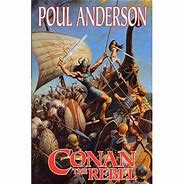Conan The Rebel, I.
We are on familiar imaginative territory. Although the magician Tothapis addresses Set as:
"'...lord of the universe...'" (p. 2)
- Set reminds Tothapis:
"'...how many and diverse are the gods of earth, sea, sky, and underworld...'" (p. 3)
Many peoples regard serpentine Set as a devil. His main divine enemy is solar Mitra, worshipped by the Hyborians (not on our map), who would tread him underfoot.
What would we do if we inhabited such a universe? Not worship Set. Tothapis' mattress is:
"...stuffed with the tresses of sacrificial maidens...'" (p. 1)
I would probably pay due respect to Mitra and to local gods while continuing to practice a form of meditation that works just as well in a universe without gods. All kinds of universes coexist in Poul Anderson's multiverse.

15 comments:
Kaor, Paul!
That was a grimly campy bit, Tothapis' mattress stuffed with the tresses of sacrificed maidens. A nice "Aztecish" touch!
Ad astra! Sean
Yup. When the Aztecs dedicated their seventh temple to "Hummingbird of the Left Hand", their war God, they sacrified 5,000 slaves in three days (more than one a minute) on the four altars -- cut their hearts out and threw the bodies down the sides of the pyramid. And ate parts of the bodies, btw.
The lake the city sat in turned brown and stank for weeks.
Kaor, Mr. Stirling!
And a big reason why the Aztecs were overthrown was because Cortes recruited allies from surrounding nations who hated the Aztecs. At least the Spanish would not sacrifice and eat them!
Ad astra! Sean
Though deaths from disease reduced the Indian population of central Mexico from about 15 million to 1.5 million over the next century. It didn't get back up to the 1492 levels until roughly 1900-1910.
Thank you for all these comments.
Kaor, Mr. Stirling!
I remember that as well, from reading Prescott's HISTORY OF THE CONQUEST OF MEXICO, how smallpox devastated the Meso-Indians, despite the effort Cortes made to stop smallpox from spreading. Long isolation from the rest of the world had made the Indians susceptible to virgin field epidemics. Smallpox, measles, the common cold, etc., killed far more Indians than wars ever did.
Ad astra! Sean
Sean: also, the founding populations of the Indian populations were quite small -- mere hundreds. That made them genetically uniform, which reduced the chance of some people having natural immunity.
Kaor, Mr. Stirling!
I should have remembered that as well. And, despite many centuries of existing in Europe, smallpox was a dreaded mass killer till vaccines and immunization was discovered.
Ad astra! Sean
Yeah, then someone noticed that milkmaids rarely had smallpox scars...
Note that a -lot- of diseases were species-jumpers; hence they became much more common when humans started keeping animals in close association with their settlements.
Kaor, Mr. Stirling!
Harry Turtledove wrote an interesting Basil Argyros story about how a smallpox vaccine was discovered precisely because of milkmaids. Centuries earlier than in our timeline.
Species jumpers: a case of "damned if we do, damned if we don't."
Ad astra! Sean
Sean: yes, keeping domestic animals was a massive boost to civilization -- note the lack of them in the New World put stringent limits on what could be done. But it came with a heavy price.
Kaor, Mr. Stirling!
A very heavy price! So much so that men of 10,000 or more years ago might have foregone domesticating animals to avoid those devastating plagues if they had known of those links with disease.
Ad astra! Sean
Sean: well, just keeping them out in the barn would have helped. But until the European middle ages, most peasants had animals in their houses.
Kaor, Mr. Stirling!
I recall seeing that many times in Anderson's stories. For greater security against cattle rustling and more warmth at night I assume.
Ad astra! Sean
Post a Comment